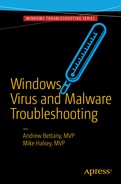Index
A
Adware
Anti-malware application
Anti-malware features
windows defender/security essentials
windows smartScreen
Antivirus
App containers
Apple II and Macintosh computers
Application programming interface (API)
ATP
AVG Antivirus
B, C
Backdoors
BCDEdit
BitLocker
Boot Configuration Data (BCD)
Botnet
Bots
Bring your own device (BYOD)
D
Demilitarized zone (DMZ)
Diagnostics and recovery toolset (DaRT)
Distributed denial-of-service (DDoS)
Door rattling
Dynamic-link library (DLL)
E
Early Launch Anti-Malware (ELAM)
E-mail and the Internet
E-mail-borne viruses and ransomware
F
Fail2ban
Firewalls
G, H
GParted tool
I, J
Infector-type viruses
Internet Explorer 11 (IE11)
Internet of Things (IoT)
K
Kaspersky Anti-Virus
Keylogging software
Kill Process
L
Link layer topology discovery (LLTD)
Linux distribution
Long term servicing branch (LTSB)
M
Macro viruses
Malicious Software Removal Tool (MSRT)
Malware
advantages
adware
backdoors
bots
history
Internet/hardware component
psychology of infection
ransomware
restricting access to files
rootkits/bootkits
spam and E-mails
Spyware
Trojan
troubleshooting problems
viruses and worms
Malware attack
e-mail and Internet
e-mail-borne viruses and ransomware
firewall attacks and DDoS
hacking application
identifying internal attacks
infector-type viruses
macro viruses
network administrators
network-based security
outcomes
requirement
rootkits and boot sector viruses
rootkit technology
“set and forget” approach
spear phishing
types of viruses
vectors and motives
virus infection
windows networking
windows PCs
Malware defense, depth
blacklists and whitelists
DMZ
firewalls
IoT
keylogging software
organizational firewalls
software firewall
UAC
windows advanced firewall
Malware Protection Center
microsoft security software
get protected
get updates
microsoft support
security software
Master file table (MFT)
MicrosoftAntiSpyware
Microsoft Baseline Security Analyzer (MBSA)
Microsoft Desktop Optimization Pack (MDOP)
Microsoft Safety Scanner
Microsoft Security Essentials
Microsoft security features
App containers
32-Bit (×86) and 64-Bit (×64) PCs
malicious software removal tool
security and maintenance
Security Center
UAC
windows firewall/advanced firewall
windows Updation
Microsoft Security Intelligence Report
Microsoft support
Microsoft Windows
N
NETBIOS
Network and Sharing Center
Network-based security
New Inbound Rule Wizard
Norton Security
O
Organizational firewalls
Organizational-level security
P, Q
Phishing Filter
Process Explorer
R
Ransomware
Registry Editor
Removing manually malware
deactivate
identify
PC isolation
PC retest
remove
test
Rootkit removal
Rootkits and boot sector viruses
Rootkits/bootkits
S
Secure Sockets Layer (SSL)
Security and maintenance
Security awareness
Security Center
Security software
comparison with Windows Defender
get protected
get updates
Software firewall
Spyware
System Reserved
T
Third-party tools
Trend Micro Antivirus+Security
Trojan
U, V
USB flash drives
User Account Control (UAC)
consent and credential
group policy settings
standard user account
Windows 10
Windows Vista
W, X, Y, Z
Win32/FakeScanti virus screenshot
Windows 7
Windows 10
click scan
malware
scan results
Windows Defender
anti-malware package
detailed malware information
home screen
malware
security software comparison with
version information
Windows Update
Windows Defender Advanced Threat Protection (ATP)
Windows defender offline (WDO)
Windows 7
Windows 10
click scan
malware
scan results
Windows 10 Enterprise
Windows startup security
BitLocker
ELAM
Secure Boot
Trusted Boot
Windows Task Manager
Windows Version
Windows XP
Winlogon tab
